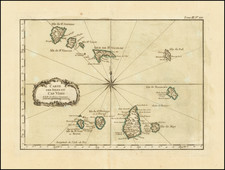Finely colored example of Liuetenant Read's map of St. Helena, published shortly after Napoleon Bonaparte's first (and second) exile.
Napoleon I's exile on the island of St Helena has contributed greatly to a heightened interest among he British public in this tiny island west of Africa. The maker, "Lieutenant Read," is otherwise unknown. It is likely that this officer was at some point posted to the island and thus in a position to add certain cartographical precisions. The map is based upon the work of John Seller in 1675 Atlas Maritimus chart of St. Helena.
The map includes topographical dedtails and is also decorated with trees, ships, cannons, residences, and even whales. The interior details are quite extensive, showing numerous plantations, houses, farms,etc.
The map is known in four editions:
- The first edition was published in October 1815 by London's Burgis & Barfoot (32 Southampton Street, The Strand). This version is the rarest – and thus most sought-after – because it lists “Buonaparte's” residence as Plantation House, which subsequently went on to become the governor's “palace”, occupied by Hudson Lowe.
- The second edition, also dated October 1815, rectified some labelling mistakes: Longwood, naturally, became Napoleon's home, Mr Balcombe's house. The Briars is changed to “Buonaparte's first residence”, and Plantation House was captioned “Residence of Governor”. The precise date of this edition is uncertain: either it is correctly dated and it was a matter of a few days or weeks between the two print runs, or the date is out by a couple of months, but the publisher did not see fit (or simply forgot) to change the print date.
- The third edition – which contained no changes – went on sale on 4 June, 1817, and was produced by a different London printing and publishing firm (this time J. M. Rippin, n° 21 Theobald's Road).
- The fourth edition – from 1841 – was released once again by Burgis & Barfoot. This edition was timed to coincide with another Napoleonic event: the return of the emperor's remains to Paris – the “Retour des Cendres” – which took place in 1840.
Shows two facsimiles of Napoleon Bonaparte's signature.











![[ Morocco ] Statuum Maroccanorum, Regnorum nempe Fessani, Maroccani, Tafiletanin et Segelomessani Secundum suas Provincias accurate divisorum, Typus generalis novus . . . 1728](https://storage.googleapis.com/raremaps/img/small/95640.jpg)
![[Untitled View of the Coast of Saint Helena]](https://storage.googleapis.com/raremaps/img/small/37759hs.jpg)
![[St. Helena] The True Description of the Island of Ascention lyeing under 8 degrees on ye South syde of ye Equinoctiall lyne.](https://storage.googleapis.com/raremaps/img/small/78964.jpg)
![[Palma, Tenerife, Gomera, Hierro] Isla Canarias 1a. Hoja](https://storage.googleapis.com/raremaps/img/small/79081.jpg)

